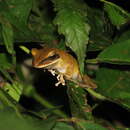pms
nòm ant ël fil


The hylid frog Hypsiboas lanciformis, known as the basin tree frog, occurs in humid tropical forests of the Amazon basin in Venezuela, Colombia, Ecuador, Peru, Bolivia, and Brazil, at altitudes up to 1500 m (5000 ft).Its back is yellow-light brown in color with darker brown stripes running cross-wise.Females reach sizes up to about 8 cm (3 inches); males are smaller.Its white upper lip and white fingertips distinguish it from all other hylids (Azevedo-Ramos et al. 2010; Rojas-Ahumada and Menin 2010).
Common throughout this range, H. lanciformis is adaptable to even very disrupted areas, and often is more frequently found in open sites than covered forest.The basin tree frog is arboreal and perches on low branches of trees and shrubs around water sources ranging from rivers to temporary pools.It reproduces year-round.Males call at night, females lay large batches of eggs in water, where the tadpoles also develop (Azevedo-Ramos et al. 2010).The advertisement call is duck-like series of bleats, described by Pansonato et al. 2011.Diego et al. (2013) describe an additional call used to dissuade predators, similar but distinct from distress calls of other hylids.
Faivovich et al. (2005) placed Hypsiboas lanciformis is in the H. albopunctatus group in their taxonomic review of the family.It is one of a number of South American frog species known to secrete skin substances with powerful antimicrobial activity; in vitro culture of skin cells may allow for production of these compounds for potential medical use (Groot et al. 2012).
The basin tree frog (Boana lanciformis) is a species of frog in the family Hylidae found in Bolivia, Brazil, Colombia, Ecuador, Peru, and Venezuela. Its natural habitats are subtropical or tropical moist lowland forests, subtropical or tropical swamps, rivers, freshwater lakes, freshwater marshes, intermittent freshwater marshes, rural gardens, and heavily degraded former forests.
{{cite journal}}: CS1 maint: multiple names: authors list (link) The basin tree frog (Boana lanciformis) is a species of frog in the family Hylidae found in Bolivia, Brazil, Colombia, Ecuador, Peru, and Venezuela. Its natural habitats are subtropical or tropical moist lowland forests, subtropical or tropical swamps, rivers, freshwater lakes, freshwater marshes, intermittent freshwater marshes, rural gardens, and heavily degraded former forests.